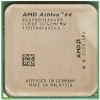AMD 3800 Evaluator Guide - Page 12
AMD64 Single Socket Processor Architecture, Table 1. Memory Bandwidth - + drivers
 |
UPC - 683728117207
View all AMD 3800 manuals
Add to My Manuals
Save this manual to your list of manuals |
Page 12 highlights
30579 Rev. 3.74 March 2007 AMD Processor Performance Evaluation Guide AMD64 Single Socket Processor Architecture Detailed knowledge of AMD 64-bit processor architecture is not required to perform optimal benchmarking. However, the benchmarks demonstrate the advantages of key architectural features. This overview provides information about those features and shows how the benchmarks demonstrate the exceptional performance of AMD processors. AMD 64-bit processors include the following architectural improvements specifically designed to increase the number of instructions per clock (IPC). • AMD64 Technology When the AMD64 Instruction Set Architecture is utilized, 64-bit mode offers: - Support for 64-bit operating systems that provide full, transparent, and simultaneous 32-bit and 64-bit platform application multitasking. - A physical address space that supports up to 1 TB of installed RAM, shattering the 4 GB RAM barrier on current x86 systems. - Sixteen 64-bit general-purpose integer registers, four times as much generalpurpose register space for applications and device drivers as traditional x86 architectures. - Sixteen 128-bit XMM registers for enhanced multimedia performance, double the register space of current SSE/SSE2/SSE3 implementations. • An integrated DDR2 memory controller (see Figure 1). - The integrated controller reduces memory latency and increases overall system performance. - When comparing platforms with different types of memory, test memory bandwidth and latency first. The results help to clarify the sometimes surprising results of more complex, application-based benchmarks. Memory is marked/marketed on bandwidth. As Table 1 shows, during tests, DDR2-800 memory can provide up to 35% more bandwidth than DDR1-400. Table 1. Memory Bandwidth Sciencemark 2.0 Bandwidth (MB/s) Sciencemark 2.0 Latency (ns) AMD Athlon™ 64 FX-62 Dual-Core Processor, DDR2-800 AMD Athlon 64 FX-60 Processor, DDR1-400 6779.3 4472.6 46.5 52.5 AMD64 Single Socket Processor Architecture 13















